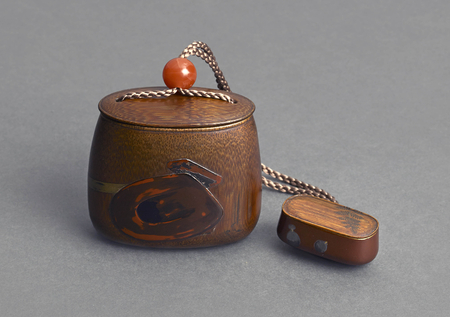Product Description
6750 Shibata Zeshin (1807-1891)
A bamboo hanging tabako-ire (tobacco container) with a design in lacquer of a suzuri (ink stone), sumi (ink), fude (brush) and a fudeoki (brush rest). The lacquer box in the form of a netsuke with a bamboo lid is decorated with warabi(fern)
Both Signed: Zeshin
Japan 19th century Edo/Meiji period
Dimensions: H. 6cm x W. 4cm (2¼” x 1½”)
Fitted wood box:
Lid with hakogaki (inscription): Zeshin-ō saku, sage tabako-ire, suzuri fude no makie. (Hanging tobacco container, with a design of an ink stone and a brush inlacquer made by an old man, Zeshin)
Lid interior hakogaki (inscription): Koma Chikushin kan (authenticated by Koma Chikushin) with the seal Chikushin
Koma Chikushin (c. 1854-1936), a disciple of Shibata Zeshin. He often wrote hakogaki (box inscriptions) and certificates for Zeshin’s work.
Shibata Zeshin (1807-1891), probably the greatest lacquer-work artist in Japanese history, based his skills on technical brilliance. Early in his training under Koma Kansai II, he realised that he needed to study other forms of art to build on his technical skills. He travelled to Kyoto where he studied the painting style of the modern Shijo School. At the same time he studied poetry and old paintings and spent a great deal of time with famous scholars such as Rai San’yo, which led to him being known firstly as a painter rather than a lacquer artist. Later in life this rich knowledge enabled him to create lacquer works that were marvelled at for their perfection and wit shown through “iki” (playful chic) and the feeling of rhythm typical of Japanese poetry. He developed several techniques of his own as well as reviving old ones, one of his greatest achievements was the revival of the fine seigai pattern, lost since the 17th century this technique involves combing through wet lacquer before it sets to create a pattern of thin waves. His trademark techniques include seido-nuri and shitan-nuri, which imitated different materials such as ancient bronze, rosewood, rusty iron and shibuichi. Unusual methods such as scratching a design onto lacquer with a rat’s tooth reveal him as an ambitious but also humorous artist who crossed the boundaries between materials and subjects with ease.
Combining his skills as a painter and lacquer artist he frequently painted urushi-e,lacquer paintings. His first painting of Mount Fuji was exhibited in 1873 at the Vienna Exposition of 1873. Although undervalued in Japan until recently, he gained numerous followers in the West who have not only been collecting his work during Zeshin’s lifetime, but also travelled to Japan to meet him in person. Many western museums have his works among their collections and his status is also being steadily re evaluated in Japan. He was chosen to be a member of the Art Committee of the Imperial Household and became a Court painter in 1890, a sign of the appreciation of his skill as an artist.
Works by the artist can be found in the collections of: British Museum, London; Fogg Art Museum, Cambridge, Ma; Freer Gallery of Art, Washington, D.C.; Metropolitan Museum of Art, New York; Art Institute of Chicago, Ill.; Museum of Fine Arts, Boston, Ma.; Stanford University Art Gallery and Museum, Ca.; Seattle Art Museum, Washington; Brooklyn Museum, New York; Royal Art History Museum, Brussels, Belgium and many others.





